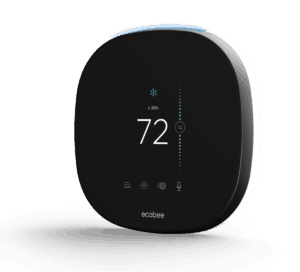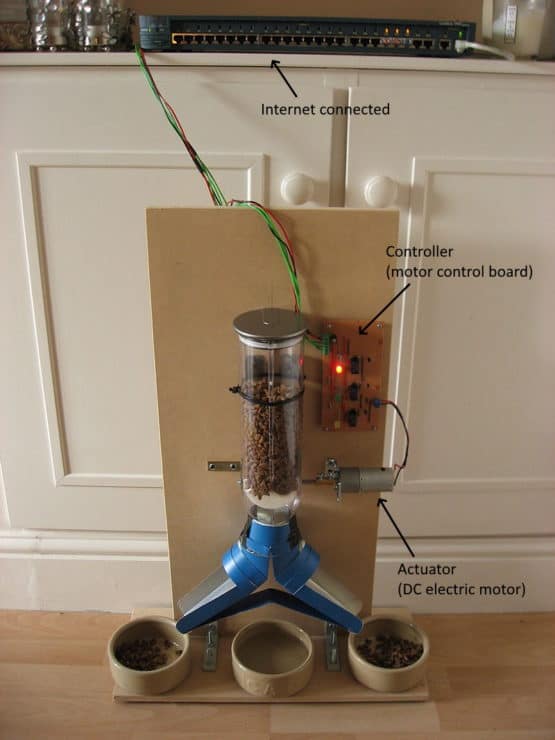“Home automation is the future”, they say. But what exactly is ‘home automation’? We might think of a coffee maker that automatically brews your coffee when your alarm goes off, or a light bulb that emits different color light depending on the time of day.

Home automation does include these things, of course, but it also covers a whole lot more.
Home automation involves a network of interconnected smart devices communicating via Bluetooth and the internet. Each device uses mechanisms and sensors to automate mundane tasks around your house, allowing you to control them via your smartphone.
Some home automation tasks can be achieved right now for relatively little cost, but some are expensive – whilst others are still a pipe dream. But even automation a few repetitive tasks around your house is worth doing, so read on to learn all that you need to know.
What is home automation (and what is its purpose)?
Have you ever thought – right before falling asleep – “is my garage door shut”? The last thing you want to do is put a dressing gown on and go outside to check. Instead you might prefer to look at a smart CCTV video feed from your mobile phone to see if it’s open.
It’d be even better if you could simply access your “door control” app which lists your smart-controlled doors and check whether the garage door is open or shut.
If the app says your garage door is open, you could click a single button and it would automatically close.
This is what home automation is all about: having automatic and electronic control of various parts of your house.

Smart thermostats are probably the best known smart device, with millions sold since they were released a decade ago. These allow you to turn your heating on/off (by setting the target temperature, against what your house’s climate currently is), but they can also learn your routines and schedules and automatically set the heating to the temperature your household most prefers. This is pretty handy, even if I do have concerns about the usefulness of smart thermostats sometimes.
So in summary, the purpose of home automation is to make your home life easier by having parts of your home electrified and internet/bluetooth-connected, so that they can be monitored and controlled automatically.
How does smart home automation work (in basic terms)?
In general, home automation involves mixing different electrical components to automate actions or devices around your house, including:
- Sensors: this is a component which monitors different parts of the environment (such as temperature, light levels and video/cameras). They collect valuable data which allows the home automation device to know how they need to act.
- Controllers: a centralized device which receives data and other inputs, and ‘works out’ what needs to be do – i.e. perform an action. This is a bit like the motherboard (and associated hardware) within a computer that receives inputs – from the keyboard and mouse- and performs ‘outputs’/actions – such as performing a calculation and showing something on the screen.
- Actuators: this is a fancy word for something which allows access, movement or control of a device, such as a light switch, motor and valve.
A home automated device can then be made smart by hooking it up to devices like smartphones via Bluetooth or most commonly the internet:
- Internet connected: an automated device can contain computer components which allow it to make internet calls to a central location, via TCP/IP and probably HTTP (similar to what happens when you access a website with your web browser).
This will involve the device transmitting data about itself to ‘the cloud’, but also allows it to accept actions to perform – such as ‘turn up the heating’, ‘close the garage door’ or ‘turn on power’ in a smart plug. - User interface: now that the device is ‘available’ on the internet, it needs some way of displaying its data – and allowing it to be controlled.
This is usually done via a smartphone app (for example to control smart thermostats or smart lightbulbs), although some smart devices also have a website-based control system (such as indoor and outdoor security cameras).
To illustrate this, NewtonNet have a funny (but valuable) example of an internet-connected cat feeder which I have illustrated to show the various parts outlined above:

There is no sensor here because it’s not needed, but they could always add a motion sensor to detect when their cat’s are nearby, hooking this up to a controller. This data can then be transmitted up to the internet and used as needed.
Equally the user interface is not shown, but this could be a smartphone app – or more likely (since this is a quick prototype) a simple private website which allows for the cat feeder to distribute the cat food as needed.
How much does it cost to automate your home?
This is the million dollar question – well, thankfully it doesn’t cost that much! But just like you can buy a new car for $15,000 to $100,000 (or a lot more!), you can also pay a small – or large – amount for automating your home.
You can start simple by picking up an Echo Dot in the sales for $24.99 and a Fire stick for $19.99. For less than $40, you now have a voice-controllable TV (well, you can control the Fire stick and the apps within it – the rest of your TV won’t be voice controlled).
You can also use the Echo Dot to automate loads of other smart devices (once you buy them), along with using it as a music and relaxation device (see below) – so it’s worth picking one up as it’s a great basis for your smart home.
You can have an smart opening/closing garage door from just $169 (although changing the door to a compatible type – if yours isn’t suitable – will probably take the cost to over $500).
A smart thermostat usually costs $200, although some models are cheaper (such as the ecobee3 lite for $150, or the Nest thermostat 3 for $240), whilst a Philips Hue smart kit (including 2 bulbs and the Philips hub) – giving an initial smart light-bulb setup – costs $99.
As you can tell, the overall cost of having a smart automated house varies a lot. If you automate all parts of your house, you could end up paying over $1,000 – but the average person will probably spend under $300 to automate 2 or 3 important parts of their house.
10 simple home automation projects examples
Using mainly ‘off the shelf’ solutions, you can achieve the following 10 home automation solutions easily enough:
- Smart lighting for waking up. Philips Hue released their range of smart light bulbs in 2012, and whilst they haven’t received widespread adoption, they are pretty useful. Their ‘Personal wake up’ labs feature can slowly introduce natural light into your room, acting as a natural alarm clock. In other words, it mirrors the natural effect that sunrise will have on you.
This leads to a much more gentle waking up, which is meant to result in you feeling more awake and alert than being rudely woken up by some rubbish alarm on your phone! - Smart outdoor lighting at night. We’ve probably all had motion-sensitive floodlights over the years, right? Whilst these are great for intruder prevention and also as a convenience for homeowners who need to go round the backyard at nighttime, a harsh floodlight hasn’t kept pace with modern life.
It is now more common to have backyard parties, or read on your patio into the evening (after it’s dark). A floodlight isn’t the best mood-setter for either activity, but smart lighting is: it can change colors depending on what you desire. This means that your lighting isn’t a barrier to parties or outdoor reading: indeed, it’s a key part of it instead. - Smart music: create ‘music zones’. Smart assistants have a range of useful features, but playing music is not always high up the list. This is despite the fact that you can link different voice assistants up, and request music on one device from another. You can also play music on a particular device from your smart assistant app (such as Google Home or Amazon Alexa).
The benefit of this is that you can create ‘music zones’: you might have two smart assistants in your children’s bedrooms or their playroom (and they can play more child friendly music). You might then have a smart assistant in your kitchen and living room, each playing different music again.
In this way, you can liven up your house whilst also playing the exact sort of music that suits each room/zone. - Smart music: white noise to improve sleep. Another lesser-used feature of smart assistants is the ability to play white noise. Google Home have a whole ‘Relax with Google Home‘ guide, whilst Amazon’s Alexa offers loads of white noises (just say “Alexa, play relaxation music” or “Alexa, play rainforest sounds”).
These are great for aiding sleeping. In-fact my wife and I recently had a baby, and white noise has proved really useful for helping our son sleep (both in our room, and when he moved to his nursery). Mind you, white noise is not just for babies: we often use white noise to help us sleep too.
A fairly technical research paper shown that white noise helps improve getting to sleep by 38%, along with other benefits. White noise can also help with concentration (such as when studying). - Smart doorbells. Are you fed up of the mailman putting your valuable parcel in your trash bin, despite your signs saying to put it in your backyard? Well a smart doorbell can help with that: when they ring the bell, your smart phone will ring – as though someone is voice calling you. When you answer, you can see – and talk to – the delivery person.
Beyond this, smart doorbells are great for preventing crime (thieves know that smart doorbells sync all video up to the cloud – meaning that they can’t just break in then destroy your doorbell, as any clips are backed up to the internet). They are also great if you want to advise visitors when you’ll be home (“hey, I’m just around the corner – wait there and I’ll be back in 5 minutes”), or avoid certain callers such as salespeople. - Control your TV with your voice. Increasing numbers of TVs and TV services offer voice control. For example, the Fire TV stick’s remote control has a voice control button – and the Apple TV supports voice control too. Samsung and other higher-end TV manufacturers have also started introducing voice control.
Whilst this might not sound too useful at first, once you start saying “switch over to channel 5” or “launch the YouTube app”, you will struggle to go back to using a boring old remote!
The Amazon Echo smart speaker also allows you to control certain TVs, such as Fire TVs and the Fire TV stick. So if you have a standard TV and don’t want to shell out $800 on an expensive one, paying $50 (in a sale!) for an Echo and a Fire stick can be a great option instead. - Automate your central heating. How does never having to touch your thermostat again sound? Well that’s the idea behind smart thermostats. Whilst you can change the temperature, they are designed to learn from you – learn what climates you like, and learn your routines. Once this is done, they can start to automate your house’s climate so that you no longer have to turn the heating on/off yourself.
- Control house access remotely. Whether you’re an Airbnb host or you’ve asked some friends to quickly check in on your house whilst you’re travelling, smart doorlocks offer remote (but secure) access to your house. In other words, you can use your doorlock app to grant access to someone on an ad-hoc basis. You can also revoke access the same way!
This can be great if something unexpected crops up and you need someone to quickly check in on your property. Also ‘remote Airbnb’ hosting has grown in popularity recently, and smart doorlocks are a great benefit in this case too. - Intrusion detection with indoor smart cameras. Smart cameras have motion detection built-in, and video captured in this case is often stored on the internet (‘in the cloud’). This means that smart cameras are great for intrusion detection, because you’ll quickly be notified of someone unexpectedly accessing your house – and you can easily see a full video of who this is.
- Smart plugs: make it look like you’re in when you’re not. When going away on vacation, it used to be common advise to put a hallway light on a mechanical timer to turn it on and off periodically. And this is still good practice, although it can be a bit too predictable. If someone is scoping out your house, they will start to see that the exact same light goes on at the exact same time each day. This is where smart plugs can come in handy.
You can remotely turn the plug on and off, meaning that the light attached to it will turn on and off as you choose. You can also set-up timers for the plug (and hence light), but vary them so that it’s far less obvious than a simple mechanical timer.

If you have any questions, feedback or suggestions about this article, please leave a comment below. Please note that all comments go into a moderation queue (to prevent blog spam). Your comment will be manually reviewed and approved by Tristan in less than a week. Thanks!